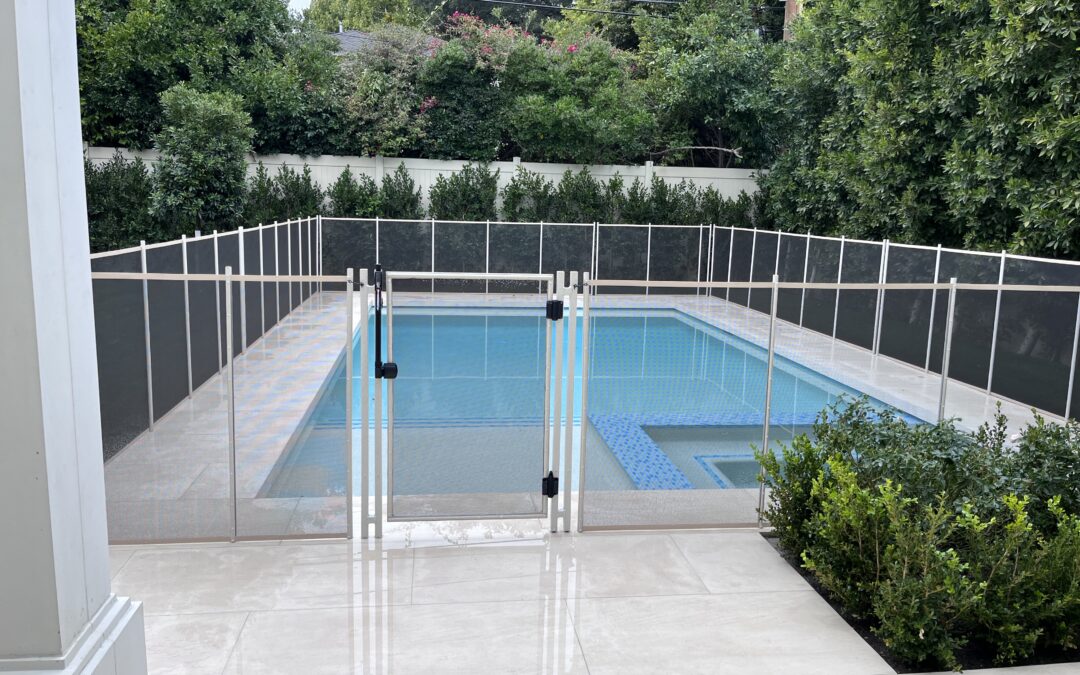Riverside County Pool Fence Regulations There are many pools in California’s Riverside County. The climate demands it. The county boundaries start just short of Los Angeles County on the west side, and extend all the way through the low deserts of Palm Springs and the Coachella Valley to the Arizona border on the east. Riverside County’s summer temperatures easily top 100 degrees Fahrenheit. In Palm Springs, daytime temperatures may not drop below that mark for weeks and months at a time. Swimming pools abound. What are the Riverside County pool fence regulations? What are the legal requirements for pool fence installation in Riverside County? Let’s take a look What’s inside this blog post:
- Riverside County pool fencing guidelines
- How Pool Defence can help.
Where to look for residential pool fencing laws in Riverside County Start with the County of Riverside Department of Building and Safety, section 421.1. There are written regulations, accompanied by drawings and sketches. What needs a pool enclosure according to Riverside County pool barrier requirements? Unlike other county and municipal regulations, the Riverside County pool fencing guidelines don’t specify what needs a pool fence. Los Angeles County defines anything with a water depth of 18 inches or more (even a pond) as requiring a fence or enclosure. Riverside Country is not that specific. This shifts the responsibility to the owner. When in doubt, call the County of Riverside Department of Building and Safety. How high does the pool enclosure have to be? The enclosure surrounding a pool has to be at least five feet (sixty inches) in height. This measurement is made on the side facing away from the swimming pool. What about ground clearance? Legal requirements for pool fences in Riverside County require that the bottom of the fence has a maximum of two inches of clearance between the ground and the fence. Again, this is measured on the side facing away from the pool. If the fence is mounted over a solid surface, such as concrete, this height can be increased to four inches. What else about the fence do I need to know
- Gaps in the fence must be such that a sphere or ball over 1-¾ inches cannot pass through. When the vertical spacing between these openings is 45 inches or more, the passage can be enlarged to allow passage of a sphere or ball less than four inches.
- If the fence consists of horizontal members and the distance between the horizontal members is less than 45 inches, those members must be located on the swimming pool side of the fence. If you are having trouble imagining this, be mindful that horizontal components of the fence can be used as ladders if they are accessible from the outside.
- If the fence consists of horizontal and vertical members, spacing between the vertical members shall not exceed 4 four inches.
- Chain link fences used as barriers shall not be less than 11 gauge.
- Any decorative design work on the outside of the fence or enclosure walls must not have protrusions, cavities, or any other type of design feature that makes it easily climbable.
- Access gates through the enclosure created by the fence shall open away from the pool.
- Access gates shall be self-closing and self-latching.
- When the self-latching gate’s release mechanism is less than 54 inches from the bottom, the locking mechanism shall be on the inside of the gate, positioned at least three inches below the top of the gate. The gate and fencing material shall not have any opening greater than one-half inches within 18 inches of the release mechanism.
- Any gates other than pedestrian gates, such as gates for cars or recreational vehicles, must be equipped with lockable hardware and padlocks and shall be locked at all times when not in use.
- When a dwelling unit such as a house serves as part of the barrier and contains door openings and access between the inside of the dwelling and the pool area, there must be a separation fence that meets all the requirements we’ve already discussed. The only exception is if 1) all doors or openings have self-closing, self-latching mechanisms, or,, 2) if, when the doors are opened, an alarm no less than 85 decibels sounds within seven seconds, and lasts more than 30 seconds. The alarm can be deactivated for a single opening by use of a switch or keypad, but that keypad has be 54 inches above the threshold of the door. The deactivation also has to automatically reset within 15 seconds.
Always check with the municipality. Swimming pool fence requirements in Riverside County and any other municipality or jurisdiction are constantly being updated. How Pool Defence can help Pool Defence is a Southern California company with over 25 years of experience building pool enclosure fences. We are experts in pool fencing and residential pool fencing laws in Riverside County. It’s our specialty. We offer the best materials, designs, and craftsmanship. Our skilled teams can usually start within two or three days of plan approval. Installation takes less than a day. Rely on Pool Defence to protect your family and provide maximum enjoyment from your pool. CALL US TODAY FOR A FREE ESTIMATE! Pool Defence serves all of Southern California from three locations. Call us at 818-900-2552 in Los Angeles, the San Fernando Valley, and Ventura County. In Riverside and Orange County, call us at 888-270-1155. Learn more on our website, www.pooldefenceus.com.


Recent Comments